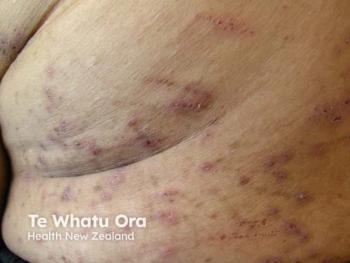
Synergy between UVA, UVB linked to UV-induced immunosuppression
The sun protection factor (SPF) is not the only measure that should be guiding the formulation of new sunscreens, according to the senior manager, worldwide regulatory affairs, L’Oreal Research and Innovation, Paris.
Montreal - The sun protection factor (SPF) is not the only measure that should be guiding the formulation of new sunscreens, according to the senior manager, worldwide regulatory affairs, L’Oreal Research and Innovation, Paris.
Individuals with darker skin phototypes are more susceptible to persistent pigment darkening (PPD) that is induced by exposure to ultraviolet A (UVA) radiation, and they need to take extra care to ensure protection against UVA, says Dominique Moyal, Ph.D.
“There is a persistent pigment darkening that is easily induced in skin phototypes III to V because of the higher content of melanin in the skin,” Dr. Moyal says.
Speaking here at an update on therapeutics in dermatology, Dr. Moyal notes that skin types are classified based on the capacity to burn and to tan and that conditions such as melasma occur in patients of darker skin types, such as Asian or Indian patients.
UVA, UVB filters
A biological endpoint, PPD, is being used to assess UVA photoprotection, Dr. Moyal says. A unique property of UVA is that it penetrates deeper into the skin than does UVB, and UVA irradiance is at least 17 times higher than UVB irradiance. To adequately cover the complete range of harmful radiation, sunscreens should contain both UVA and UVB filters, she says.
The growing concern about the deleterious impact of UVA is leading some researchers to look at additional measures in developing sunscreens. One of those measures is UVA protection factor (UVAPF). A sunscreen can carry a particular SPF but possess insufficient protection against UVA.
“You can have two sunscreens that offer SPF of 30, but the protection factor of UVA may be different,” Dr. Moyal says. “Only a well-balanced product is able to decrease UVA-induced pigmentation.”
Well-balanced protection is defined by a UVAPF at least one-third of the SPF, and products that fulfill this criterion are identified with a UVA logo, Dr. Moyal says.
Factors that contribute to that difference include if the UVA filters are subject to degradation when exposed to UV. Consequently, a filter such as avobenzone should ideally be paired with a UVB filter such as octocrylene to ensure avobenzone’s efficacy in terms of its protection against UVA, Dr. Moyal says.
Full protection over the entire UVA range, effective absorption in both the long UVA and short UVA, is required, Dr. Moyal adds.
Photoimmunosuppression
Like UVB, UVA is involved in the induction of photoimmunosuppression, according to Dr. Moyal.
A study published in the British Journal of Dermatology showed that human epidermal Langerhans cells were modified with a single exposure to either UV solar simulated radiation, or ultraviolet B and UVA or UVA radiation alone (Seité S, Zucchi H, Moyal D, et al. Br J Dermatol. 2003;148(2):291-299).
To protect patients against UV-induced immunosuppression, they need to be protected against UVA and UVB, according to Robert Bissonnette, M.D., F.R.C.P.C., a dermatologist based in Montreal, with Innovaderm Research.
“You don’t need (to be exposed to) a high dose of radiation to create UV immunosuppression,” says Dr. Bissonnette, noting the impact of UV radiation on Langerhans cells has been well-studied. “There appears to be a synergistic effect between UVA and UVB.”
The mechanisms involved in UV immunosuppression are fairly complex, Dr. Bissonnette says.
“Immunosuppressive effects of UV radiation could explain the association between sun exposure and a decrease in the incidence of other diseases like multiple sclerosis,” Dr. Bissonnette says. “Some studies suggest that sun exposure in childhood has a protective effect against such diseases.”
Dermatologists should individualize their treatment plans around the issue of photoprotection for their patients, Dr. Bissonnette explains.
“The impact of UV-induced immunosuppression is different from one patient to another,” he says. “The approach I would take with a patient who has a phototype II skin type and works outdoors is different from what I would do with a patient who has a phototype VI skin type and who spends most of his time indoors.”
Disclosures: Dr. Bissonnette has received honoraria and/or research grants from Pierre-Fabre, L’Oreal and La Roche-Posay.
Newsletter
Like what you’re reading? Subscribe to Dermatology Times for weekly updates on therapies, innovations, and real-world practice tips.


















